Clinical Reasoning Cycle | Nursing Assignment
VerifiedAdded on 2022/09/18
|15
|4268
|34
AI Summary
Contribute Materials
Your contribution can guide someone’s learning journey. Share your
documents today.
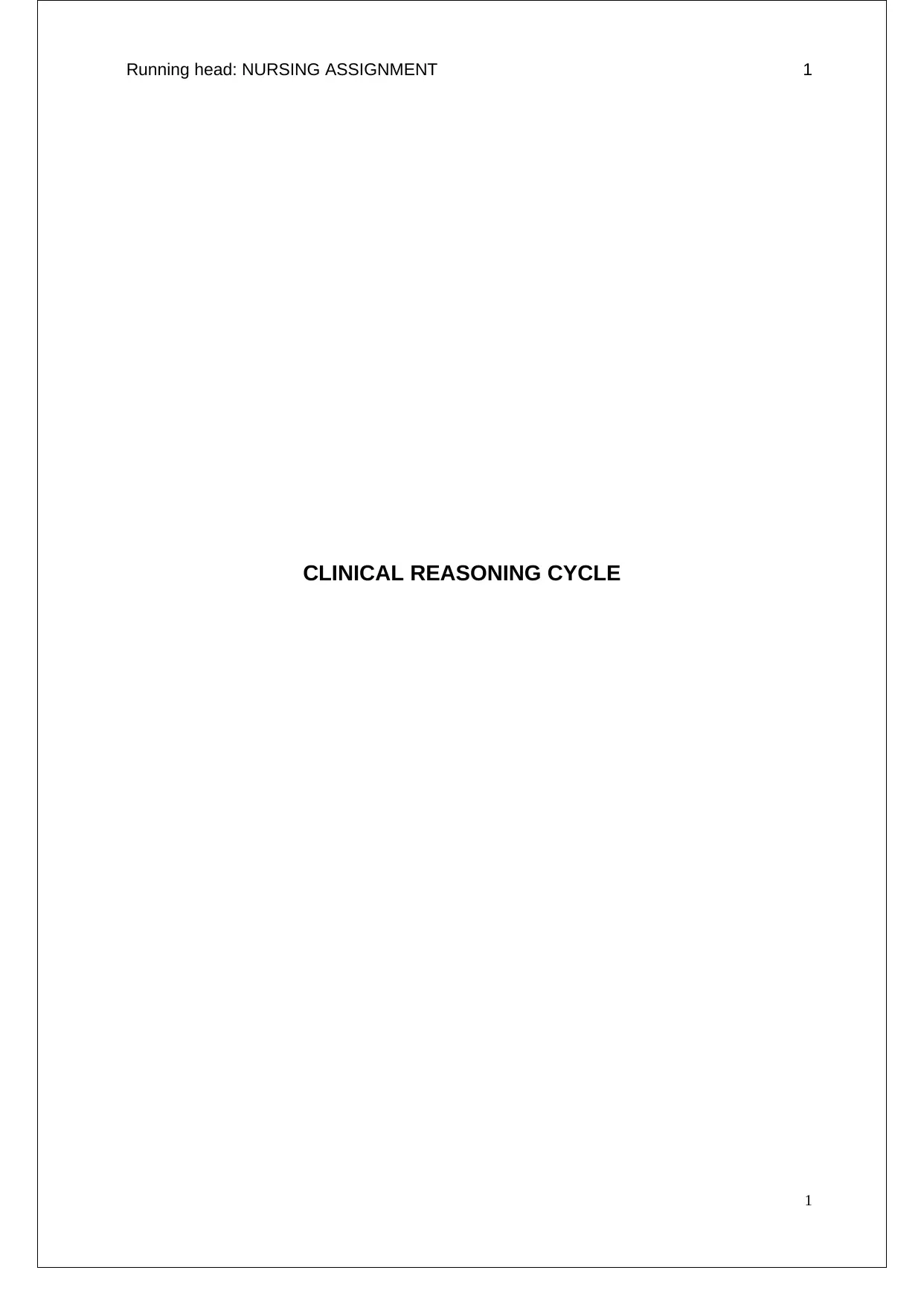
Running head: NURSING ASSIGNMENT 1
CLINICAL REASONING CYCLE
1
CLINICAL REASONING CYCLE
1
Secure Best Marks with AI Grader
Need help grading? Try our AI Grader for instant feedback on your assignments.
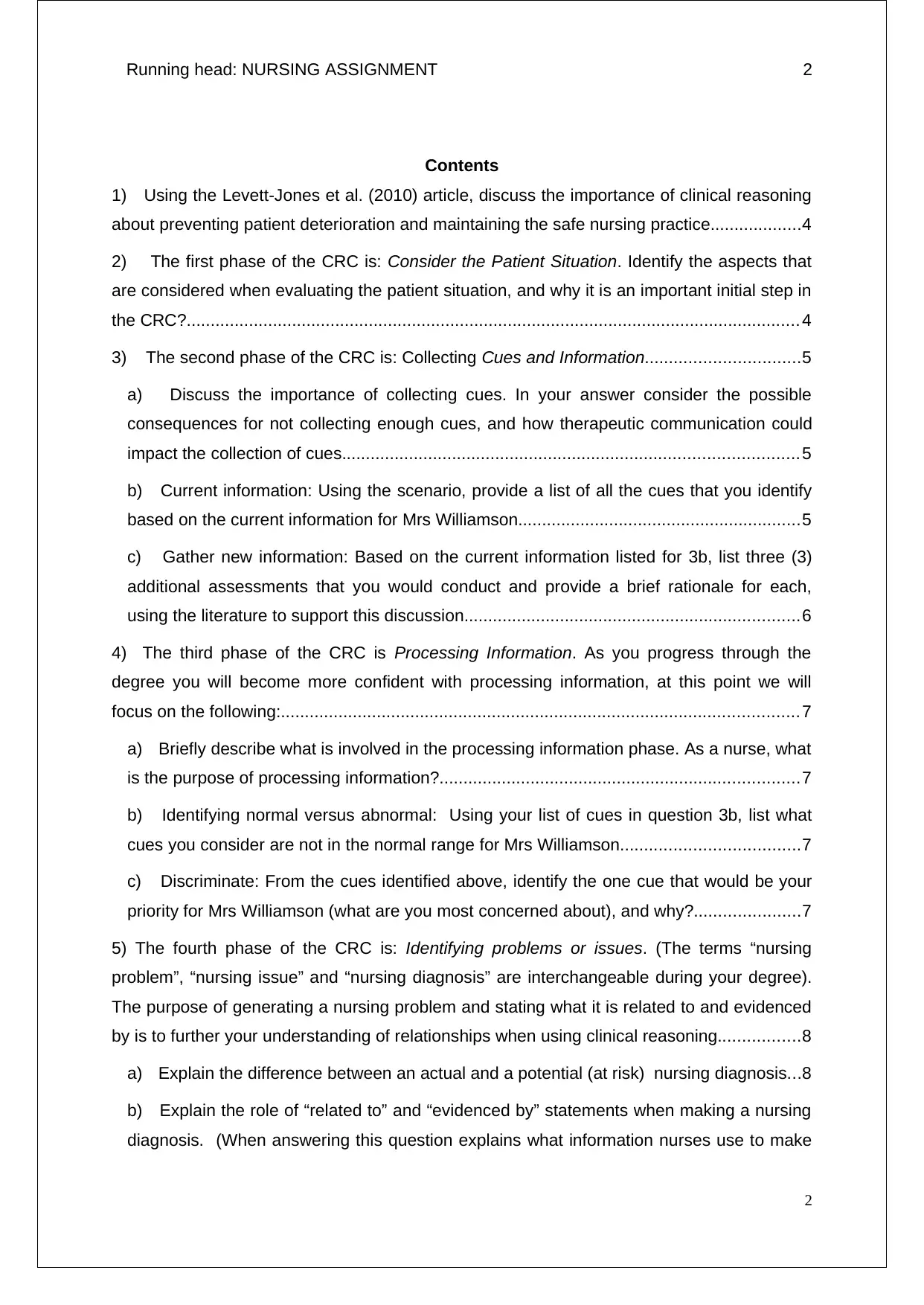
Running head: NURSING ASSIGNMENT 2
Contents
1) Using the Levett-Jones et al. (2010) article, discuss the importance of clinical reasoning
about preventing patient deterioration and maintaining the safe nursing practice...................4
2) The first phase of the CRC is: Consider the Patient Situation. Identify the aspects that
are considered when evaluating the patient situation, and why it is an important initial step in
the CRC?................................................................................................................................ 4
3) The second phase of the CRC is: Collecting Cues and Information................................5
a) Discuss the importance of collecting cues. In your answer consider the possible
consequences for not collecting enough cues, and how therapeutic communication could
impact the collection of cues...............................................................................................5
b) Current information: Using the scenario, provide a list of all the cues that you identify
based on the current information for Mrs Williamson...........................................................5
c) Gather new information: Based on the current information listed for 3b, list three (3)
additional assessments that you would conduct and provide a brief rationale for each,
using the literature to support this discussion......................................................................6
4) The third phase of the CRC is Processing Information. As you progress through the
degree you will become more confident with processing information, at this point we will
focus on the following:............................................................................................................7
a) Briefly describe what is involved in the processing information phase. As a nurse, what
is the purpose of processing information?...........................................................................7
b) Identifying normal versus abnormal: Using your list of cues in question 3b, list what
cues you consider are not in the normal range for Mrs Williamson.....................................7
c) Discriminate: From the cues identified above, identify the one cue that would be your
priority for Mrs Williamson (what are you most concerned about), and why?......................7
5) The fourth phase of the CRC is: Identifying problems or issues. (The terms “nursing
problem”, “nursing issue” and “nursing diagnosis” are interchangeable during your degree).
The purpose of generating a nursing problem and stating what it is related to and evidenced
by is to further your understanding of relationships when using clinical reasoning.................8
a) Explain the difference between an actual and a potential (at risk) nursing diagnosis...8
b) Explain the role of “related to” and “evidenced by” statements when making a nursing
diagnosis. (When answering this question explains what information nurses use to make
2
Contents
1) Using the Levett-Jones et al. (2010) article, discuss the importance of clinical reasoning
about preventing patient deterioration and maintaining the safe nursing practice...................4
2) The first phase of the CRC is: Consider the Patient Situation. Identify the aspects that
are considered when evaluating the patient situation, and why it is an important initial step in
the CRC?................................................................................................................................ 4
3) The second phase of the CRC is: Collecting Cues and Information................................5
a) Discuss the importance of collecting cues. In your answer consider the possible
consequences for not collecting enough cues, and how therapeutic communication could
impact the collection of cues...............................................................................................5
b) Current information: Using the scenario, provide a list of all the cues that you identify
based on the current information for Mrs Williamson...........................................................5
c) Gather new information: Based on the current information listed for 3b, list three (3)
additional assessments that you would conduct and provide a brief rationale for each,
using the literature to support this discussion......................................................................6
4) The third phase of the CRC is Processing Information. As you progress through the
degree you will become more confident with processing information, at this point we will
focus on the following:............................................................................................................7
a) Briefly describe what is involved in the processing information phase. As a nurse, what
is the purpose of processing information?...........................................................................7
b) Identifying normal versus abnormal: Using your list of cues in question 3b, list what
cues you consider are not in the normal range for Mrs Williamson.....................................7
c) Discriminate: From the cues identified above, identify the one cue that would be your
priority for Mrs Williamson (what are you most concerned about), and why?......................7
5) The fourth phase of the CRC is: Identifying problems or issues. (The terms “nursing
problem”, “nursing issue” and “nursing diagnosis” are interchangeable during your degree).
The purpose of generating a nursing problem and stating what it is related to and evidenced
by is to further your understanding of relationships when using clinical reasoning.................8
a) Explain the difference between an actual and a potential (at risk) nursing diagnosis...8
b) Explain the role of “related to” and “evidenced by” statements when making a nursing
diagnosis. (When answering this question explains what information nurses use to make
2
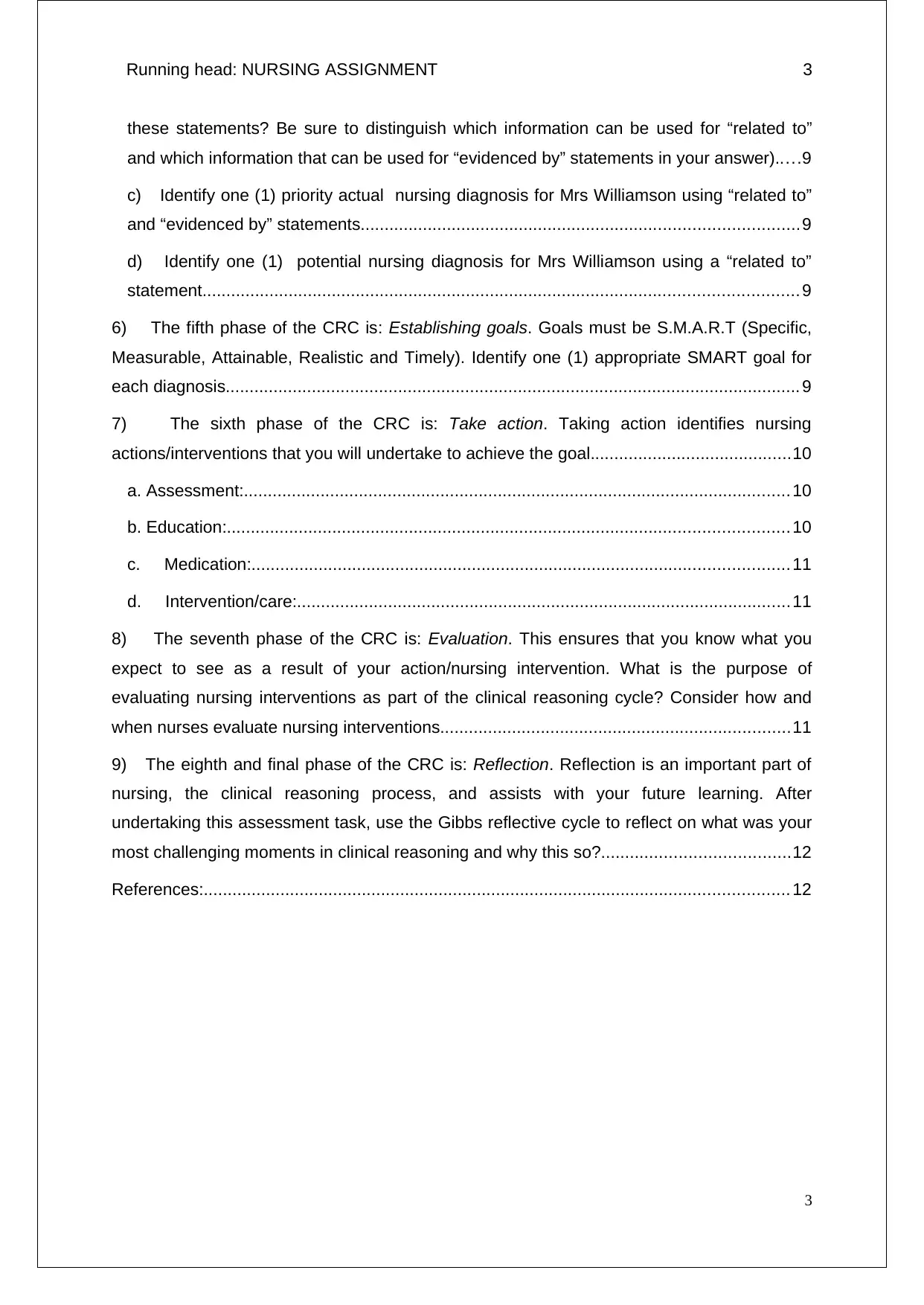
Running head: NURSING ASSIGNMENT 3
these statements? Be sure to distinguish which information can be used for “related to”
and which information that can be used for “evidenced by” statements in your answer).....9
c) Identify one (1) priority actual nursing diagnosis for Mrs Williamson using “related to”
and “evidenced by” statements...........................................................................................9
d) Identify one (1) potential nursing diagnosis for Mrs Williamson using a “related to”
statement............................................................................................................................ 9
6) The fifth phase of the CRC is: Establishing goals. Goals must be S.M.A.R.T (Specific,
Measurable, Attainable, Realistic and Timely). Identify one (1) appropriate SMART goal for
each diagnosis........................................................................................................................ 9
7) The sixth phase of the CRC is: Take action. Taking action identifies nursing
actions/interventions that you will undertake to achieve the goal..........................................10
a. Assessment:.................................................................................................................. 10
b. Education:..................................................................................................................... 10
c. Medication:................................................................................................................ 11
d. Intervention/care:.......................................................................................................11
8) The seventh phase of the CRC is: Evaluation. This ensures that you know what you
expect to see as a result of your action/nursing intervention. What is the purpose of
evaluating nursing interventions as part of the clinical reasoning cycle? Consider how and
when nurses evaluate nursing interventions.........................................................................11
9) The eighth and final phase of the CRC is: Reflection. Reflection is an important part of
nursing, the clinical reasoning process, and assists with your future learning. After
undertaking this assessment task, use the Gibbs reflective cycle to reflect on what was your
most challenging moments in clinical reasoning and why this so?.......................................12
References:.......................................................................................................................... 12
3
these statements? Be sure to distinguish which information can be used for “related to”
and which information that can be used for “evidenced by” statements in your answer).....9
c) Identify one (1) priority actual nursing diagnosis for Mrs Williamson using “related to”
and “evidenced by” statements...........................................................................................9
d) Identify one (1) potential nursing diagnosis for Mrs Williamson using a “related to”
statement............................................................................................................................ 9
6) The fifth phase of the CRC is: Establishing goals. Goals must be S.M.A.R.T (Specific,
Measurable, Attainable, Realistic and Timely). Identify one (1) appropriate SMART goal for
each diagnosis........................................................................................................................ 9
7) The sixth phase of the CRC is: Take action. Taking action identifies nursing
actions/interventions that you will undertake to achieve the goal..........................................10
a. Assessment:.................................................................................................................. 10
b. Education:..................................................................................................................... 10
c. Medication:................................................................................................................ 11
d. Intervention/care:.......................................................................................................11
8) The seventh phase of the CRC is: Evaluation. This ensures that you know what you
expect to see as a result of your action/nursing intervention. What is the purpose of
evaluating nursing interventions as part of the clinical reasoning cycle? Consider how and
when nurses evaluate nursing interventions.........................................................................11
9) The eighth and final phase of the CRC is: Reflection. Reflection is an important part of
nursing, the clinical reasoning process, and assists with your future learning. After
undertaking this assessment task, use the Gibbs reflective cycle to reflect on what was your
most challenging moments in clinical reasoning and why this so?.......................................12
References:.......................................................................................................................... 12
3
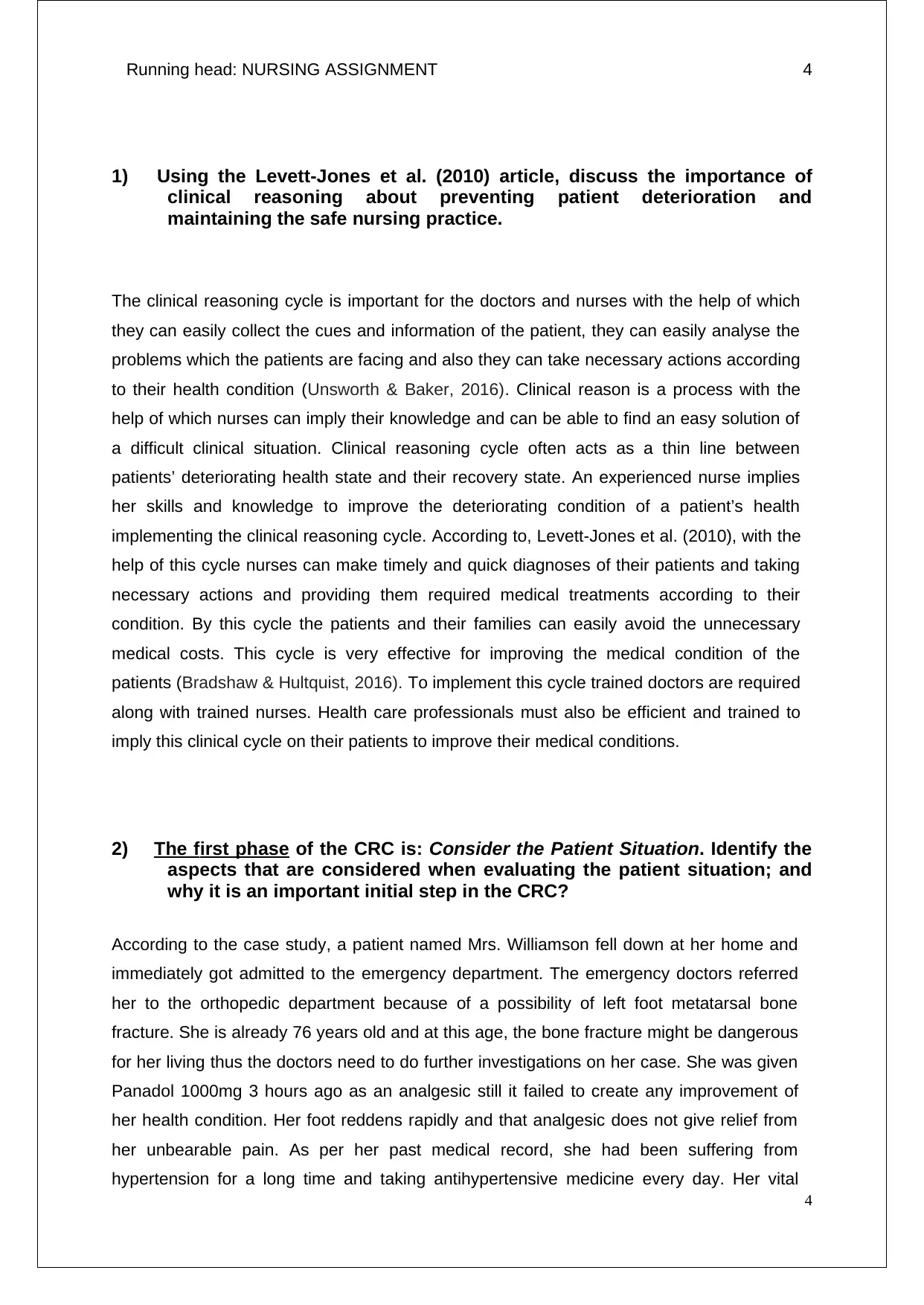
Running head: NURSING ASSIGNMENT 4
1) Using the Levett-Jones et al. (2010) article, discuss the importance of
clinical reasoning about preventing patient deterioration and
maintaining the safe nursing practice.
The clinical reasoning cycle is important for the doctors and nurses with the help of which
they can easily collect the cues and information of the patient, they can easily analyse the
problems which the patients are facing and also they can take necessary actions according
to their health condition (Unsworth & Baker, 2016). Clinical reason is a process with the
help of which nurses can imply their knowledge and can be able to find an easy solution of
a difficult clinical situation. Clinical reasoning cycle often acts as a thin line between
patients’ deteriorating health state and their recovery state. An experienced nurse implies
her skills and knowledge to improve the deteriorating condition of a patient’s health
implementing the clinical reasoning cycle. According to, Levett-Jones et al. (2010), with the
help of this cycle nurses can make timely and quick diagnoses of their patients and taking
necessary actions and providing them required medical treatments according to their
condition. By this cycle the patients and their families can easily avoid the unnecessary
medical costs. This cycle is very effective for improving the medical condition of the
patients (Bradshaw & Hultquist, 2016). To implement this cycle trained doctors are required
along with trained nurses. Health care professionals must also be efficient and trained to
imply this clinical cycle on their patients to improve their medical conditions.
2) The first phase of the CRC is: Consider the Patient Situation. Identify the
aspects that are considered when evaluating the patient situation; and
why it is an important initial step in the CRC?
According to the case study, a patient named Mrs. Williamson fell down at her home and
immediately got admitted to the emergency department. The emergency doctors referred
her to the orthopedic department because of a possibility of left foot metatarsal bone
fracture. She is already 76 years old and at this age, the bone fracture might be dangerous
for her living thus the doctors need to do further investigations on her case. She was given
Panadol 1000mg 3 hours ago as an analgesic still it failed to create any improvement of
her health condition. Her foot reddens rapidly and that analgesic does not give relief from
her unbearable pain. As per her past medical record, she had been suffering from
hypertension for a long time and taking antihypertensive medicine every day. Her vital
4
1) Using the Levett-Jones et al. (2010) article, discuss the importance of
clinical reasoning about preventing patient deterioration and
maintaining the safe nursing practice.
The clinical reasoning cycle is important for the doctors and nurses with the help of which
they can easily collect the cues and information of the patient, they can easily analyse the
problems which the patients are facing and also they can take necessary actions according
to their health condition (Unsworth & Baker, 2016). Clinical reason is a process with the
help of which nurses can imply their knowledge and can be able to find an easy solution of
a difficult clinical situation. Clinical reasoning cycle often acts as a thin line between
patients’ deteriorating health state and their recovery state. An experienced nurse implies
her skills and knowledge to improve the deteriorating condition of a patient’s health
implementing the clinical reasoning cycle. According to, Levett-Jones et al. (2010), with the
help of this cycle nurses can make timely and quick diagnoses of their patients and taking
necessary actions and providing them required medical treatments according to their
condition. By this cycle the patients and their families can easily avoid the unnecessary
medical costs. This cycle is very effective for improving the medical condition of the
patients (Bradshaw & Hultquist, 2016). To implement this cycle trained doctors are required
along with trained nurses. Health care professionals must also be efficient and trained to
imply this clinical cycle on their patients to improve their medical conditions.
2) The first phase of the CRC is: Consider the Patient Situation. Identify the
aspects that are considered when evaluating the patient situation; and
why it is an important initial step in the CRC?
According to the case study, a patient named Mrs. Williamson fell down at her home and
immediately got admitted to the emergency department. The emergency doctors referred
her to the orthopedic department because of a possibility of left foot metatarsal bone
fracture. She is already 76 years old and at this age, the bone fracture might be dangerous
for her living thus the doctors need to do further investigations on her case. She was given
Panadol 1000mg 3 hours ago as an analgesic still it failed to create any improvement of
her health condition. Her foot reddens rapidly and that analgesic does not give relief from
her unbearable pain. As per her past medical record, she had been suffering from
hypertension for a long time and taking antihypertensive medicine every day. Her vital
4
Secure Best Marks with AI Grader
Need help grading? Try our AI Grader for instant feedback on your assignments.
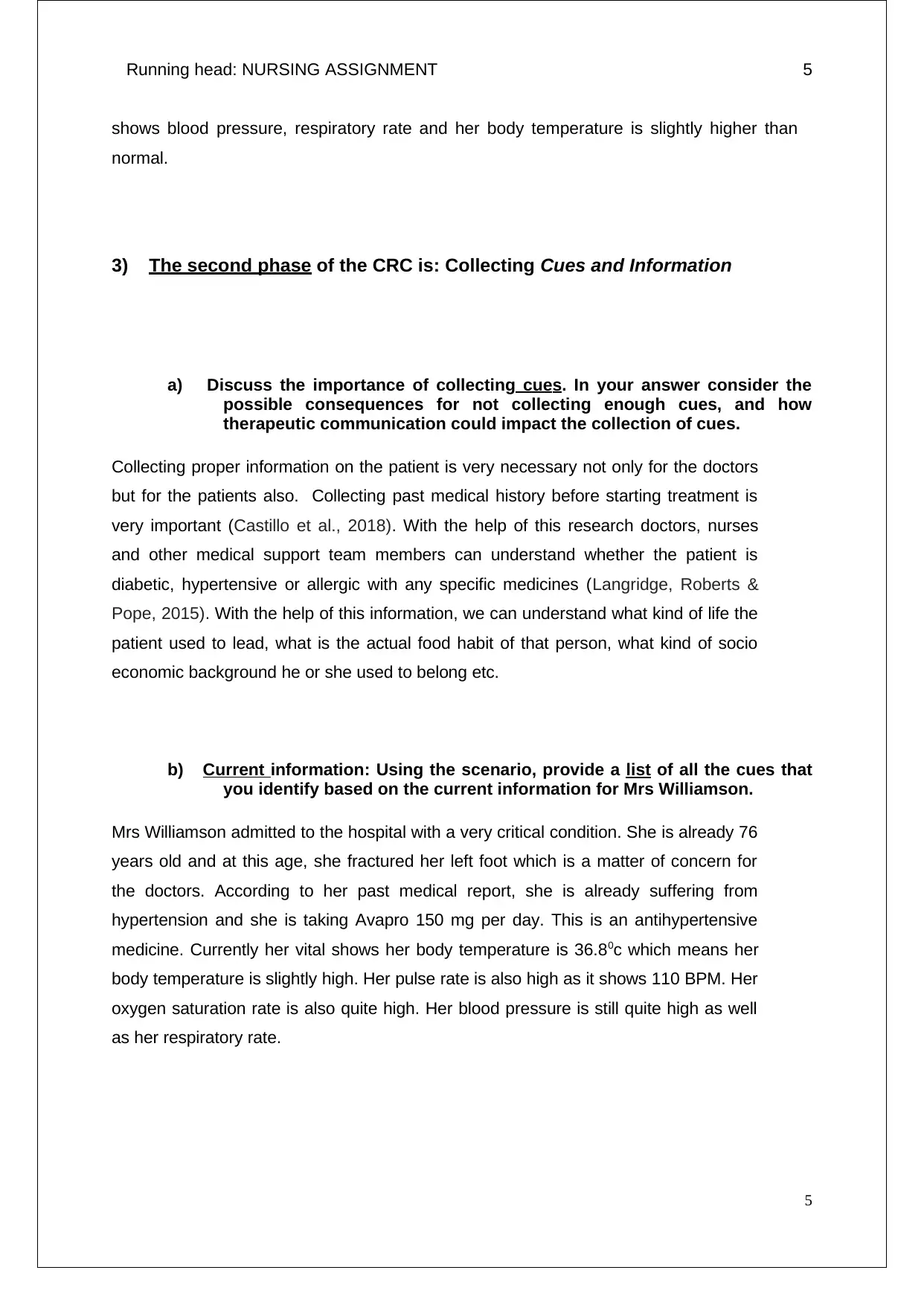
Running head: NURSING ASSIGNMENT 5
shows blood pressure, respiratory rate and her body temperature is slightly higher than
normal.
3) The second phase of the CRC is: Collecting Cues and Information
a) Discuss the importance of collecting cues. In your answer consider the
possible consequences for not collecting enough cues, and how
therapeutic communication could impact the collection of cues.
Collecting proper information on the patient is very necessary not only for the doctors
but for the patients also. Collecting past medical history before starting treatment is
very important (Castillo et al., 2018). With the help of this research doctors, nurses
and other medical support team members can understand whether the patient is
diabetic, hypertensive or allergic with any specific medicines (Langridge, Roberts &
Pope, 2015). With the help of this information, we can understand what kind of life the
patient used to lead, what is the actual food habit of that person, what kind of socio
economic background he or she used to belong etc.
b) Current information: Using the scenario, provide a list of all the cues that
you identify based on the current information for Mrs Williamson.
Mrs Williamson admitted to the hospital with a very critical condition. She is already 76
years old and at this age, she fractured her left foot which is a matter of concern for
the doctors. According to her past medical report, she is already suffering from
hypertension and she is taking Avapro 150 mg per day. This is an antihypertensive
medicine. Currently her vital shows her body temperature is 36.80c which means her
body temperature is slightly high. Her pulse rate is also high as it shows 110 BPM. Her
oxygen saturation rate is also quite high. Her blood pressure is still quite high as well
as her respiratory rate.
5
shows blood pressure, respiratory rate and her body temperature is slightly higher than
normal.
3) The second phase of the CRC is: Collecting Cues and Information
a) Discuss the importance of collecting cues. In your answer consider the
possible consequences for not collecting enough cues, and how
therapeutic communication could impact the collection of cues.
Collecting proper information on the patient is very necessary not only for the doctors
but for the patients also. Collecting past medical history before starting treatment is
very important (Castillo et al., 2018). With the help of this research doctors, nurses
and other medical support team members can understand whether the patient is
diabetic, hypertensive or allergic with any specific medicines (Langridge, Roberts &
Pope, 2015). With the help of this information, we can understand what kind of life the
patient used to lead, what is the actual food habit of that person, what kind of socio
economic background he or she used to belong etc.
b) Current information: Using the scenario, provide a list of all the cues that
you identify based on the current information for Mrs Williamson.
Mrs Williamson admitted to the hospital with a very critical condition. She is already 76
years old and at this age, she fractured her left foot which is a matter of concern for
the doctors. According to her past medical report, she is already suffering from
hypertension and she is taking Avapro 150 mg per day. This is an antihypertensive
medicine. Currently her vital shows her body temperature is 36.80c which means her
body temperature is slightly high. Her pulse rate is also high as it shows 110 BPM. Her
oxygen saturation rate is also quite high. Her blood pressure is still quite high as well
as her respiratory rate.
5
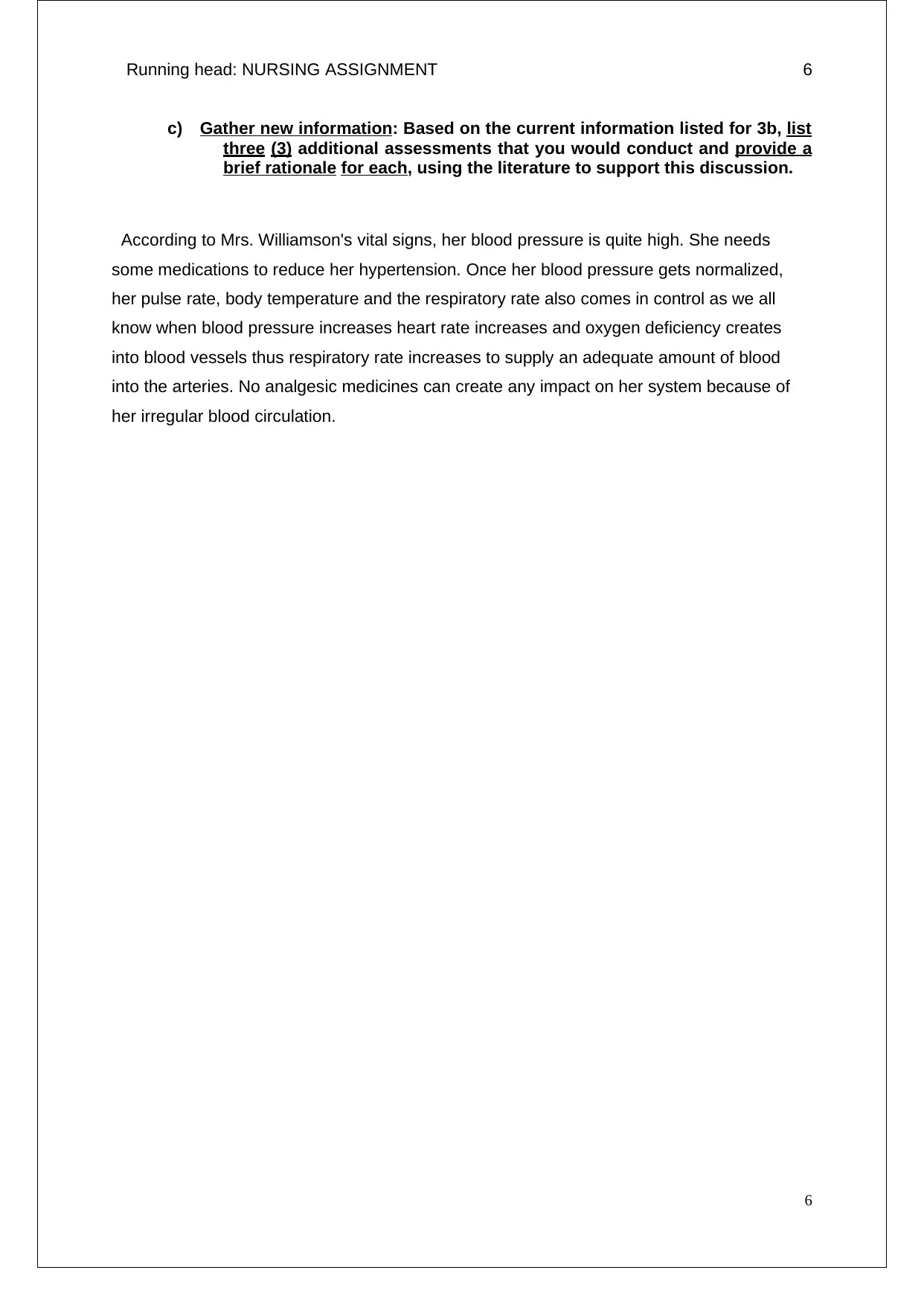
Running head: NURSING ASSIGNMENT 6
c) Gather new information: Based on the current information listed for 3b, list
three (3) additional assessments that you would conduct and provide a
brief rationale for each, using the literature to support this discussion.
According to Mrs. Williamson's vital signs, her blood pressure is quite high. She needs
some medications to reduce her hypertension. Once her blood pressure gets normalized,
her pulse rate, body temperature and the respiratory rate also comes in control as we all
know when blood pressure increases heart rate increases and oxygen deficiency creates
into blood vessels thus respiratory rate increases to supply an adequate amount of blood
into the arteries. No analgesic medicines can create any impact on her system because of
her irregular blood circulation.
6
c) Gather new information: Based on the current information listed for 3b, list
three (3) additional assessments that you would conduct and provide a
brief rationale for each, using the literature to support this discussion.
According to Mrs. Williamson's vital signs, her blood pressure is quite high. She needs
some medications to reduce her hypertension. Once her blood pressure gets normalized,
her pulse rate, body temperature and the respiratory rate also comes in control as we all
know when blood pressure increases heart rate increases and oxygen deficiency creates
into blood vessels thus respiratory rate increases to supply an adequate amount of blood
into the arteries. No analgesic medicines can create any impact on her system because of
her irregular blood circulation.
6
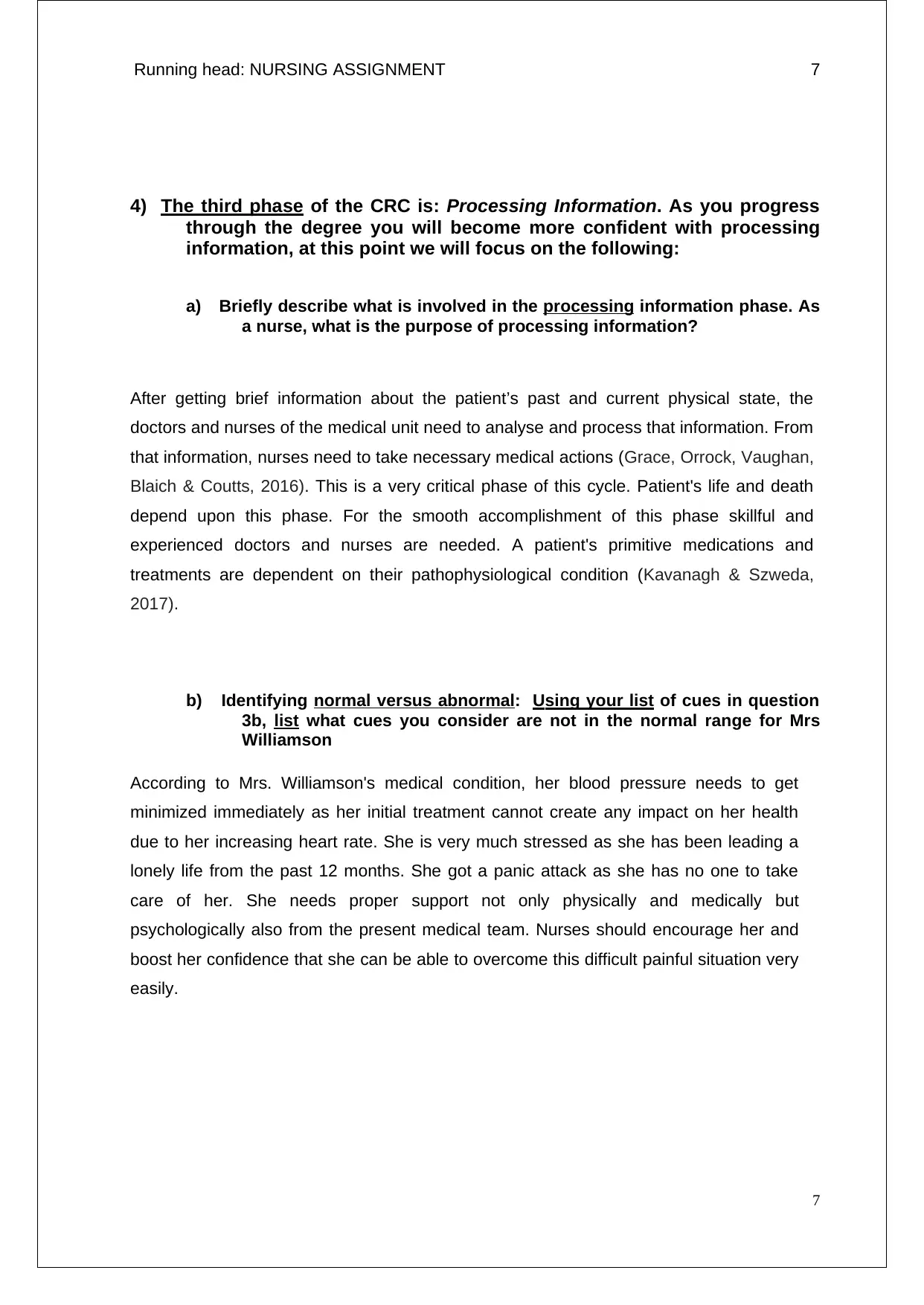
Running head: NURSING ASSIGNMENT 7
4) The third phase of the CRC is: Processing Information. As you progress
through the degree you will become more confident with processing
information, at this point we will focus on the following:
a) Briefly describe what is involved in the processing information phase. As
a nurse, what is the purpose of processing information?
After getting brief information about the patient’s past and current physical state, the
doctors and nurses of the medical unit need to analyse and process that information. From
that information, nurses need to take necessary medical actions (Grace, Orrock, Vaughan,
Blaich & Coutts, 2016). This is a very critical phase of this cycle. Patient's life and death
depend upon this phase. For the smooth accomplishment of this phase skillful and
experienced doctors and nurses are needed. A patient's primitive medications and
treatments are dependent on their pathophysiological condition (Kavanagh & Szweda,
2017).
b) Identifying normal versus abnormal: Using your list of cues in question
3b, list what cues you consider are not in the normal range for Mrs
Williamson
According to Mrs. Williamson's medical condition, her blood pressure needs to get
minimized immediately as her initial treatment cannot create any impact on her health
due to her increasing heart rate. She is very much stressed as she has been leading a
lonely life from the past 12 months. She got a panic attack as she has no one to take
care of her. She needs proper support not only physically and medically but
psychologically also from the present medical team. Nurses should encourage her and
boost her confidence that she can be able to overcome this difficult painful situation very
easily.
7
4) The third phase of the CRC is: Processing Information. As you progress
through the degree you will become more confident with processing
information, at this point we will focus on the following:
a) Briefly describe what is involved in the processing information phase. As
a nurse, what is the purpose of processing information?
After getting brief information about the patient’s past and current physical state, the
doctors and nurses of the medical unit need to analyse and process that information. From
that information, nurses need to take necessary medical actions (Grace, Orrock, Vaughan,
Blaich & Coutts, 2016). This is a very critical phase of this cycle. Patient's life and death
depend upon this phase. For the smooth accomplishment of this phase skillful and
experienced doctors and nurses are needed. A patient's primitive medications and
treatments are dependent on their pathophysiological condition (Kavanagh & Szweda,
2017).
b) Identifying normal versus abnormal: Using your list of cues in question
3b, list what cues you consider are not in the normal range for Mrs
Williamson
According to Mrs. Williamson's medical condition, her blood pressure needs to get
minimized immediately as her initial treatment cannot create any impact on her health
due to her increasing heart rate. She is very much stressed as she has been leading a
lonely life from the past 12 months. She got a panic attack as she has no one to take
care of her. She needs proper support not only physically and medically but
psychologically also from the present medical team. Nurses should encourage her and
boost her confidence that she can be able to overcome this difficult painful situation very
easily.
7
Paraphrase This Document
Need a fresh take? Get an instant paraphrase of this document with our AI Paraphraser
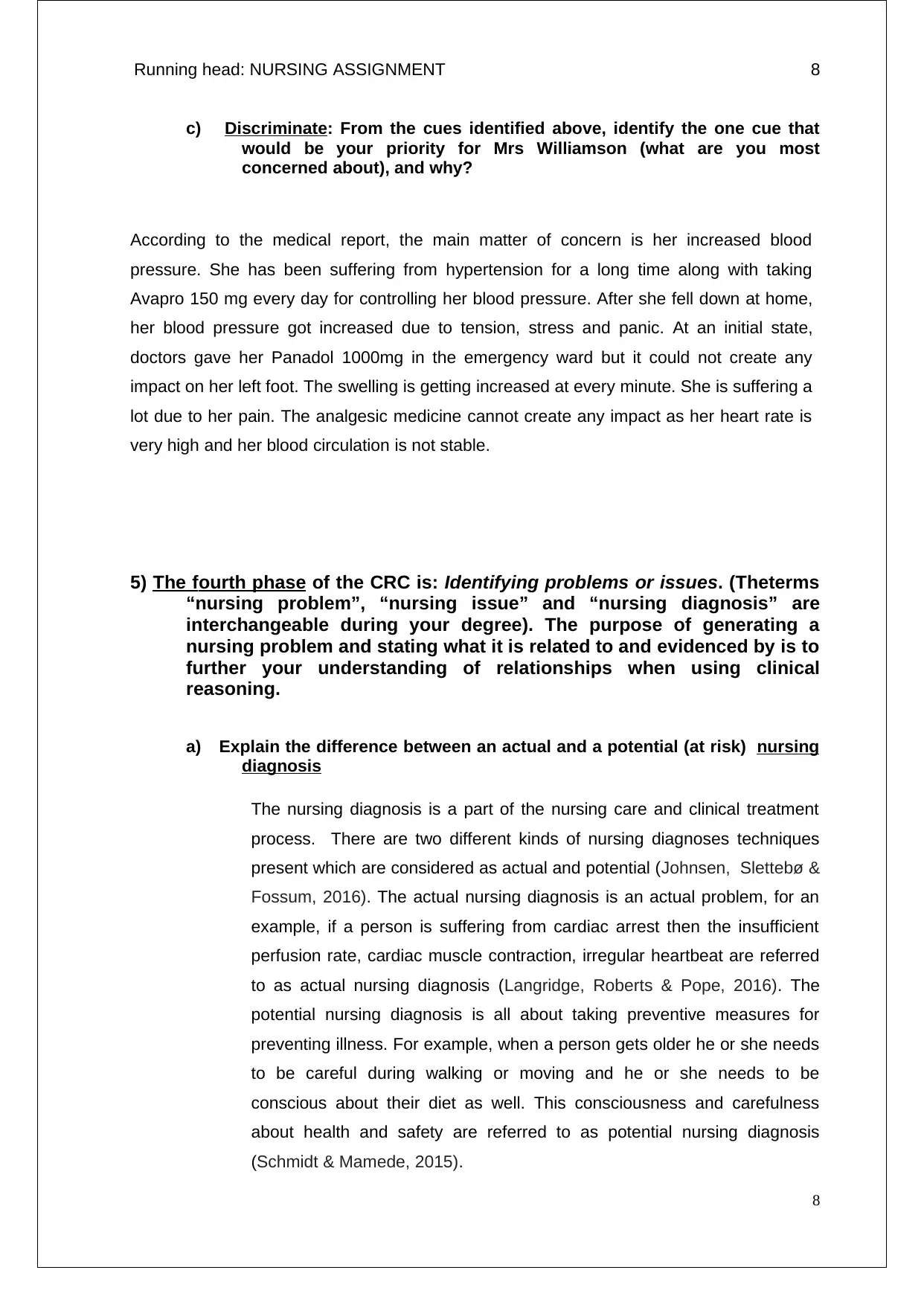
Running head: NURSING ASSIGNMENT 8
c) Discriminate: From the cues identified above, identify the one cue that
would be your priority for Mrs Williamson (what are you most
concerned about), and why?
According to the medical report, the main matter of concern is her increased blood
pressure. She has been suffering from hypertension for a long time along with taking
Avapro 150 mg every day for controlling her blood pressure. After she fell down at home,
her blood pressure got increased due to tension, stress and panic. At an initial state,
doctors gave her Panadol 1000mg in the emergency ward but it could not create any
impact on her left foot. The swelling is getting increased at every minute. She is suffering a
lot due to her pain. The analgesic medicine cannot create any impact as her heart rate is
very high and her blood circulation is not stable.
5) The fourth phase of the CRC is: Identifying problems or issues. (Theterms
“nursing problem”, “nursing issue” and “nursing diagnosis” are
interchangeable during your degree). The purpose of generating a
nursing problem and stating what it is related to and evidenced by is to
further your understanding of relationships when using clinical
reasoning.
a) Explain the difference between an actual and a potential (at risk) nursing
diagnosis
The nursing diagnosis is a part of the nursing care and clinical treatment
process. There are two different kinds of nursing diagnoses techniques
present which are considered as actual and potential (Johnsen, Slettebø &
Fossum, 2016). The actual nursing diagnosis is an actual problem, for an
example, if a person is suffering from cardiac arrest then the insufficient
perfusion rate, cardiac muscle contraction, irregular heartbeat are referred
to as actual nursing diagnosis (Langridge, Roberts & Pope, 2016). The
potential nursing diagnosis is all about taking preventive measures for
preventing illness. For example, when a person gets older he or she needs
to be careful during walking or moving and he or she needs to be
conscious about their diet as well. This consciousness and carefulness
about health and safety are referred to as potential nursing diagnosis
(Schmidt & Mamede, 2015).
8
c) Discriminate: From the cues identified above, identify the one cue that
would be your priority for Mrs Williamson (what are you most
concerned about), and why?
According to the medical report, the main matter of concern is her increased blood
pressure. She has been suffering from hypertension for a long time along with taking
Avapro 150 mg every day for controlling her blood pressure. After she fell down at home,
her blood pressure got increased due to tension, stress and panic. At an initial state,
doctors gave her Panadol 1000mg in the emergency ward but it could not create any
impact on her left foot. The swelling is getting increased at every minute. She is suffering a
lot due to her pain. The analgesic medicine cannot create any impact as her heart rate is
very high and her blood circulation is not stable.
5) The fourth phase of the CRC is: Identifying problems or issues. (Theterms
“nursing problem”, “nursing issue” and “nursing diagnosis” are
interchangeable during your degree). The purpose of generating a
nursing problem and stating what it is related to and evidenced by is to
further your understanding of relationships when using clinical
reasoning.
a) Explain the difference between an actual and a potential (at risk) nursing
diagnosis
The nursing diagnosis is a part of the nursing care and clinical treatment
process. There are two different kinds of nursing diagnoses techniques
present which are considered as actual and potential (Johnsen, Slettebø &
Fossum, 2016). The actual nursing diagnosis is an actual problem, for an
example, if a person is suffering from cardiac arrest then the insufficient
perfusion rate, cardiac muscle contraction, irregular heartbeat are referred
to as actual nursing diagnosis (Langridge, Roberts & Pope, 2016). The
potential nursing diagnosis is all about taking preventive measures for
preventing illness. For example, when a person gets older he or she needs
to be careful during walking or moving and he or she needs to be
conscious about their diet as well. This consciousness and carefulness
about health and safety are referred to as potential nursing diagnosis
(Schmidt & Mamede, 2015).
8
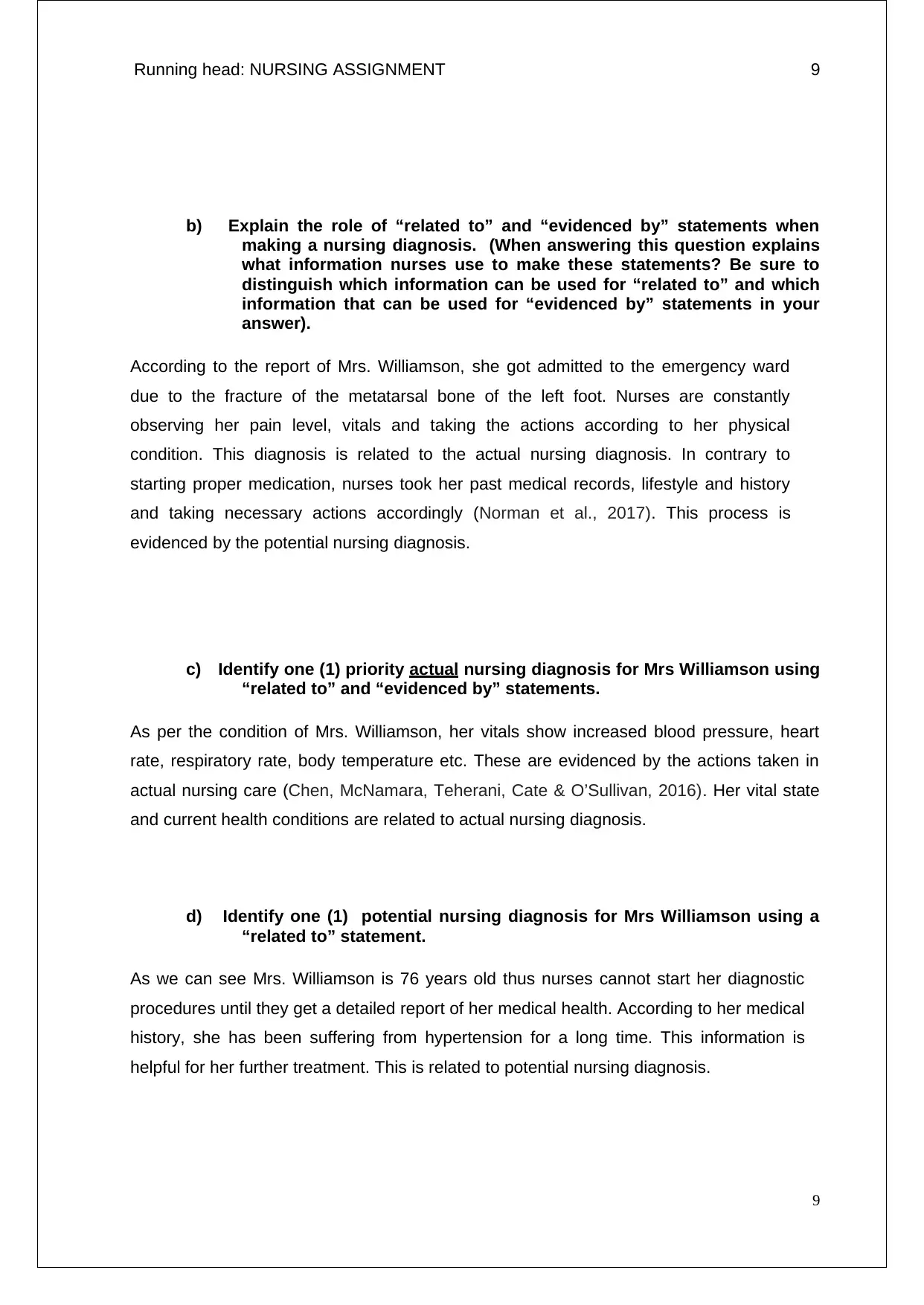
Running head: NURSING ASSIGNMENT 9
b) Explain the role of “related to” and “evidenced by” statements when
making a nursing diagnosis. (When answering this question explains
what information nurses use to make these statements? Be sure to
distinguish which information can be used for “related to” and which
information that can be used for “evidenced by” statements in your
answer).
According to the report of Mrs. Williamson, she got admitted to the emergency ward
due to the fracture of the metatarsal bone of the left foot. Nurses are constantly
observing her pain level, vitals and taking the actions according to her physical
condition. This diagnosis is related to the actual nursing diagnosis. In contrary to
starting proper medication, nurses took her past medical records, lifestyle and history
and taking necessary actions accordingly (Norman et al., 2017). This process is
evidenced by the potential nursing diagnosis.
c) Identify one (1) priority actual nursing diagnosis for Mrs Williamson using
“related to” and “evidenced by” statements.
As per the condition of Mrs. Williamson, her vitals show increased blood pressure, heart
rate, respiratory rate, body temperature etc. These are evidenced by the actions taken in
actual nursing care (Chen, McNamara, Teherani, Cate & O’Sullivan, 2016). Her vital state
and current health conditions are related to actual nursing diagnosis.
d) Identify one (1) potential nursing diagnosis for Mrs Williamson using a
“related to” statement.
As we can see Mrs. Williamson is 76 years old thus nurses cannot start her diagnostic
procedures until they get a detailed report of her medical health. According to her medical
history, she has been suffering from hypertension for a long time. This information is
helpful for her further treatment. This is related to potential nursing diagnosis.
9
b) Explain the role of “related to” and “evidenced by” statements when
making a nursing diagnosis. (When answering this question explains
what information nurses use to make these statements? Be sure to
distinguish which information can be used for “related to” and which
information that can be used for “evidenced by” statements in your
answer).
According to the report of Mrs. Williamson, she got admitted to the emergency ward
due to the fracture of the metatarsal bone of the left foot. Nurses are constantly
observing her pain level, vitals and taking the actions according to her physical
condition. This diagnosis is related to the actual nursing diagnosis. In contrary to
starting proper medication, nurses took her past medical records, lifestyle and history
and taking necessary actions accordingly (Norman et al., 2017). This process is
evidenced by the potential nursing diagnosis.
c) Identify one (1) priority actual nursing diagnosis for Mrs Williamson using
“related to” and “evidenced by” statements.
As per the condition of Mrs. Williamson, her vitals show increased blood pressure, heart
rate, respiratory rate, body temperature etc. These are evidenced by the actions taken in
actual nursing care (Chen, McNamara, Teherani, Cate & O’Sullivan, 2016). Her vital state
and current health conditions are related to actual nursing diagnosis.
d) Identify one (1) potential nursing diagnosis for Mrs Williamson using a
“related to” statement.
As we can see Mrs. Williamson is 76 years old thus nurses cannot start her diagnostic
procedures until they get a detailed report of her medical health. According to her medical
history, she has been suffering from hypertension for a long time. This information is
helpful for her further treatment. This is related to potential nursing diagnosis.
9
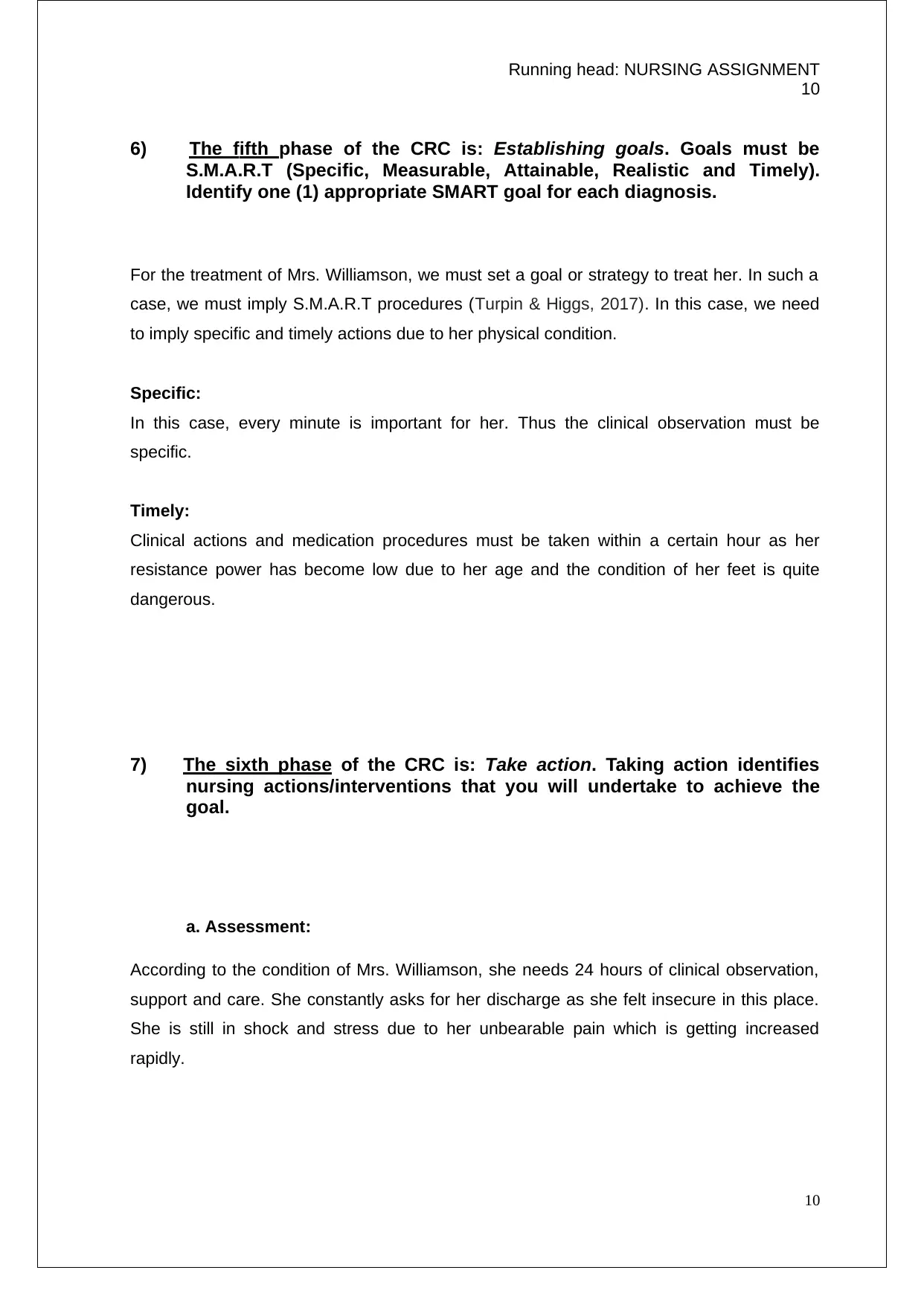
Running head: NURSING ASSIGNMENT
10
6) The fifth phase of the CRC is: Establishing goals. Goals must be
S.M.A.R.T (Specific, Measurable, Attainable, Realistic and Timely).
Identify one (1) appropriate SMART goal for each diagnosis.
For the treatment of Mrs. Williamson, we must set a goal or strategy to treat her. In such a
case, we must imply S.M.A.R.T procedures (Turpin & Higgs, 2017). In this case, we need
to imply specific and timely actions due to her physical condition.
Specific:
In this case, every minute is important for her. Thus the clinical observation must be
specific.
Timely:
Clinical actions and medication procedures must be taken within a certain hour as her
resistance power has become low due to her age and the condition of her feet is quite
dangerous.
7) The sixth phase of the CRC is: Take action. Taking action identifies
nursing actions/interventions that you will undertake to achieve the
goal.
a. Assessment:
According to the condition of Mrs. Williamson, she needs 24 hours of clinical observation,
support and care. She constantly asks for her discharge as she felt insecure in this place.
She is still in shock and stress due to her unbearable pain which is getting increased
rapidly.
10
10
6) The fifth phase of the CRC is: Establishing goals. Goals must be
S.M.A.R.T (Specific, Measurable, Attainable, Realistic and Timely).
Identify one (1) appropriate SMART goal for each diagnosis.
For the treatment of Mrs. Williamson, we must set a goal or strategy to treat her. In such a
case, we must imply S.M.A.R.T procedures (Turpin & Higgs, 2017). In this case, we need
to imply specific and timely actions due to her physical condition.
Specific:
In this case, every minute is important for her. Thus the clinical observation must be
specific.
Timely:
Clinical actions and medication procedures must be taken within a certain hour as her
resistance power has become low due to her age and the condition of her feet is quite
dangerous.
7) The sixth phase of the CRC is: Take action. Taking action identifies
nursing actions/interventions that you will undertake to achieve the
goal.
a. Assessment:
According to the condition of Mrs. Williamson, she needs 24 hours of clinical observation,
support and care. She constantly asks for her discharge as she felt insecure in this place.
She is still in shock and stress due to her unbearable pain which is getting increased
rapidly.
10
Secure Best Marks with AI Grader
Need help grading? Try our AI Grader for instant feedback on your assignments.
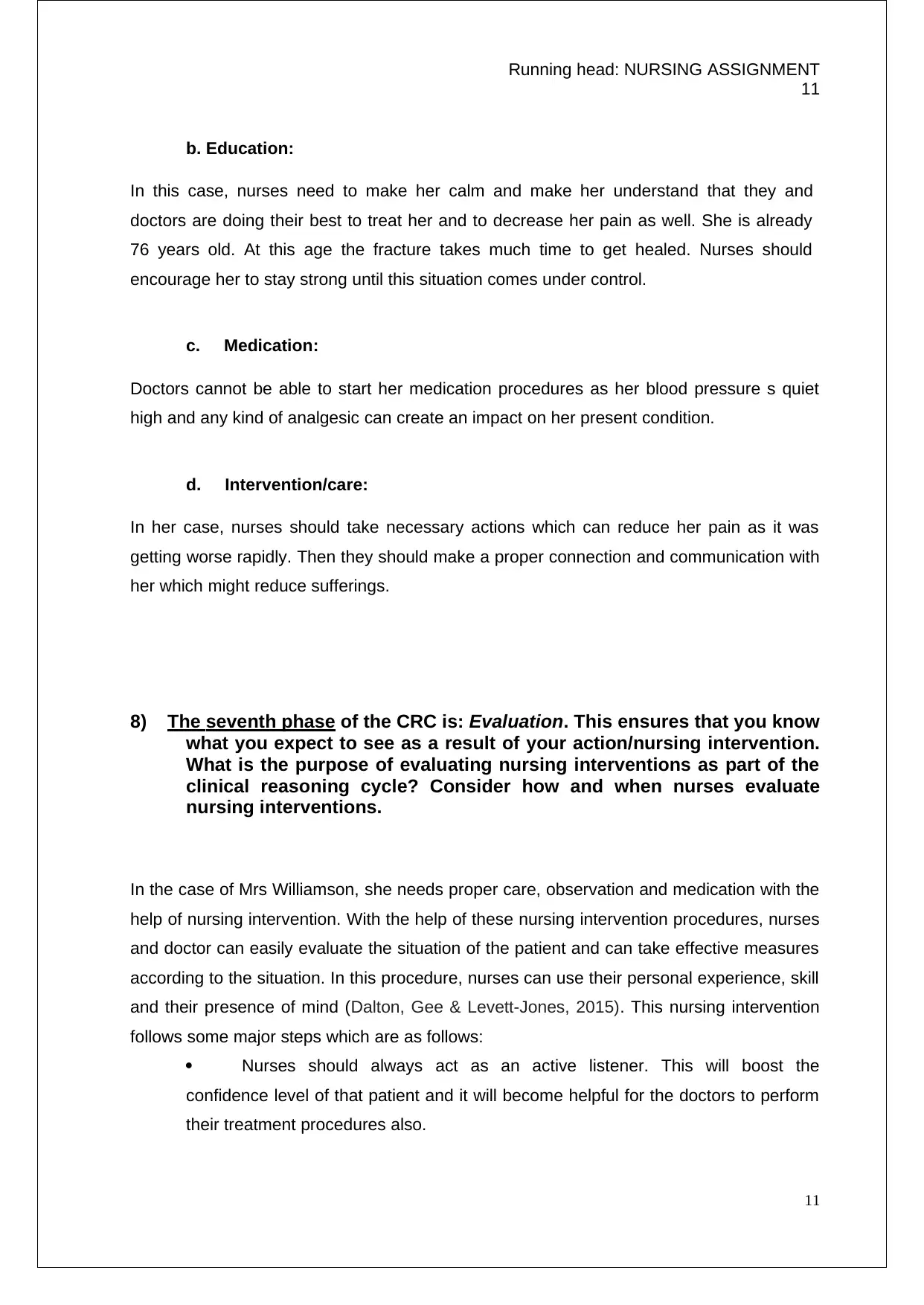
Running head: NURSING ASSIGNMENT
11
b. Education:
In this case, nurses need to make her calm and make her understand that they and
doctors are doing their best to treat her and to decrease her pain as well. She is already
76 years old. At this age the fracture takes much time to get healed. Nurses should
encourage her to stay strong until this situation comes under control.
c. Medication:
Doctors cannot be able to start her medication procedures as her blood pressure s quiet
high and any kind of analgesic can create an impact on her present condition.
d. Intervention/care:
In her case, nurses should take necessary actions which can reduce her pain as it was
getting worse rapidly. Then they should make a proper connection and communication with
her which might reduce sufferings.
8) The seventh phase of the CRC is: Evaluation. This ensures that you know
what you expect to see as a result of your action/nursing intervention.
What is the purpose of evaluating nursing interventions as part of the
clinical reasoning cycle? Consider how and when nurses evaluate
nursing interventions.
In the case of Mrs Williamson, she needs proper care, observation and medication with the
help of nursing intervention. With the help of these nursing intervention procedures, nurses
and doctor can easily evaluate the situation of the patient and can take effective measures
according to the situation. In this procedure, nurses can use their personal experience, skill
and their presence of mind (Dalton, Gee & Levett-Jones, 2015). This nursing intervention
follows some major steps which are as follows:
Nurses should always act as an active listener. This will boost the
confidence level of that patient and it will become helpful for the doctors to perform
their treatment procedures also.
11
11
b. Education:
In this case, nurses need to make her calm and make her understand that they and
doctors are doing their best to treat her and to decrease her pain as well. She is already
76 years old. At this age the fracture takes much time to get healed. Nurses should
encourage her to stay strong until this situation comes under control.
c. Medication:
Doctors cannot be able to start her medication procedures as her blood pressure s quiet
high and any kind of analgesic can create an impact on her present condition.
d. Intervention/care:
In her case, nurses should take necessary actions which can reduce her pain as it was
getting worse rapidly. Then they should make a proper connection and communication with
her which might reduce sufferings.
8) The seventh phase of the CRC is: Evaluation. This ensures that you know
what you expect to see as a result of your action/nursing intervention.
What is the purpose of evaluating nursing interventions as part of the
clinical reasoning cycle? Consider how and when nurses evaluate
nursing interventions.
In the case of Mrs Williamson, she needs proper care, observation and medication with the
help of nursing intervention. With the help of these nursing intervention procedures, nurses
and doctor can easily evaluate the situation of the patient and can take effective measures
according to the situation. In this procedure, nurses can use their personal experience, skill
and their presence of mind (Dalton, Gee & Levett-Jones, 2015). This nursing intervention
follows some major steps which are as follows:
Nurses should always act as an active listener. This will boost the
confidence level of that patient and it will become helpful for the doctors to perform
their treatment procedures also.
11
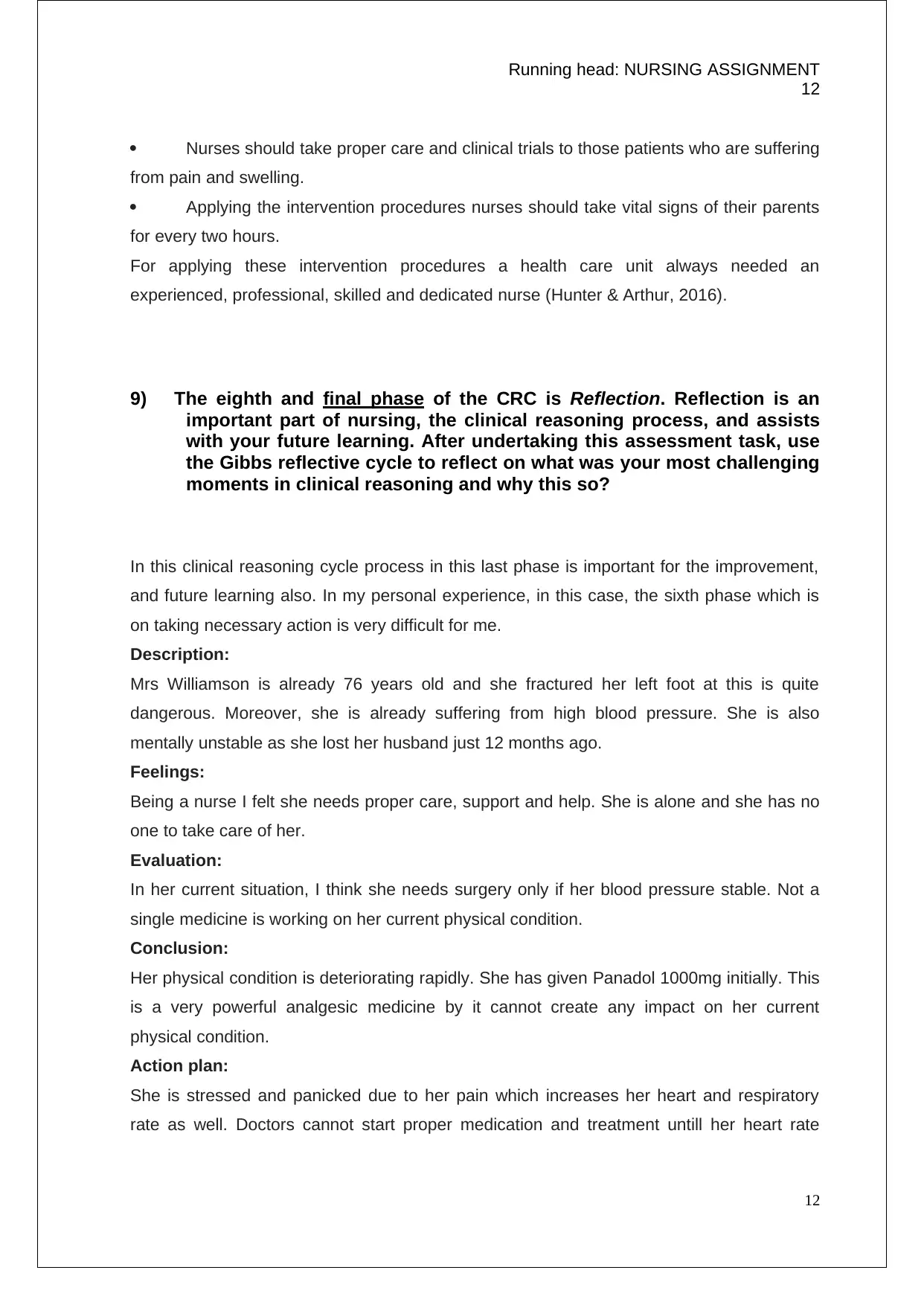
Running head: NURSING ASSIGNMENT
12
Nurses should take proper care and clinical trials to those patients who are suffering
from pain and swelling.
Applying the intervention procedures nurses should take vital signs of their parents
for every two hours.
For applying these intervention procedures a health care unit always needed an
experienced, professional, skilled and dedicated nurse (Hunter & Arthur, 2016).
9) The eighth and final phase of the CRC is Reflection. Reflection is an
important part of nursing, the clinical reasoning process, and assists
with your future learning. After undertaking this assessment task, use
the Gibbs reflective cycle to reflect on what was your most challenging
moments in clinical reasoning and why this so?
In this clinical reasoning cycle process in this last phase is important for the improvement,
and future learning also. In my personal experience, in this case, the sixth phase which is
on taking necessary action is very difficult for me.
Description:
Mrs Williamson is already 76 years old and she fractured her left foot at this is quite
dangerous. Moreover, she is already suffering from high blood pressure. She is also
mentally unstable as she lost her husband just 12 months ago.
Feelings:
Being a nurse I felt she needs proper care, support and help. She is alone and she has no
one to take care of her.
Evaluation:
In her current situation, I think she needs surgery only if her blood pressure stable. Not a
single medicine is working on her current physical condition.
Conclusion:
Her physical condition is deteriorating rapidly. She has given Panadol 1000mg initially. This
is a very powerful analgesic medicine by it cannot create any impact on her current
physical condition.
Action plan:
She is stressed and panicked due to her pain which increases her heart and respiratory
rate as well. Doctors cannot start proper medication and treatment untill her heart rate
12
12
Nurses should take proper care and clinical trials to those patients who are suffering
from pain and swelling.
Applying the intervention procedures nurses should take vital signs of their parents
for every two hours.
For applying these intervention procedures a health care unit always needed an
experienced, professional, skilled and dedicated nurse (Hunter & Arthur, 2016).
9) The eighth and final phase of the CRC is Reflection. Reflection is an
important part of nursing, the clinical reasoning process, and assists
with your future learning. After undertaking this assessment task, use
the Gibbs reflective cycle to reflect on what was your most challenging
moments in clinical reasoning and why this so?
In this clinical reasoning cycle process in this last phase is important for the improvement,
and future learning also. In my personal experience, in this case, the sixth phase which is
on taking necessary action is very difficult for me.
Description:
Mrs Williamson is already 76 years old and she fractured her left foot at this is quite
dangerous. Moreover, she is already suffering from high blood pressure. She is also
mentally unstable as she lost her husband just 12 months ago.
Feelings:
Being a nurse I felt she needs proper care, support and help. She is alone and she has no
one to take care of her.
Evaluation:
In her current situation, I think she needs surgery only if her blood pressure stable. Not a
single medicine is working on her current physical condition.
Conclusion:
Her physical condition is deteriorating rapidly. She has given Panadol 1000mg initially. This
is a very powerful analgesic medicine by it cannot create any impact on her current
physical condition.
Action plan:
She is stressed and panicked due to her pain which increases her heart and respiratory
rate as well. Doctors cannot start proper medication and treatment untill her heart rate
12
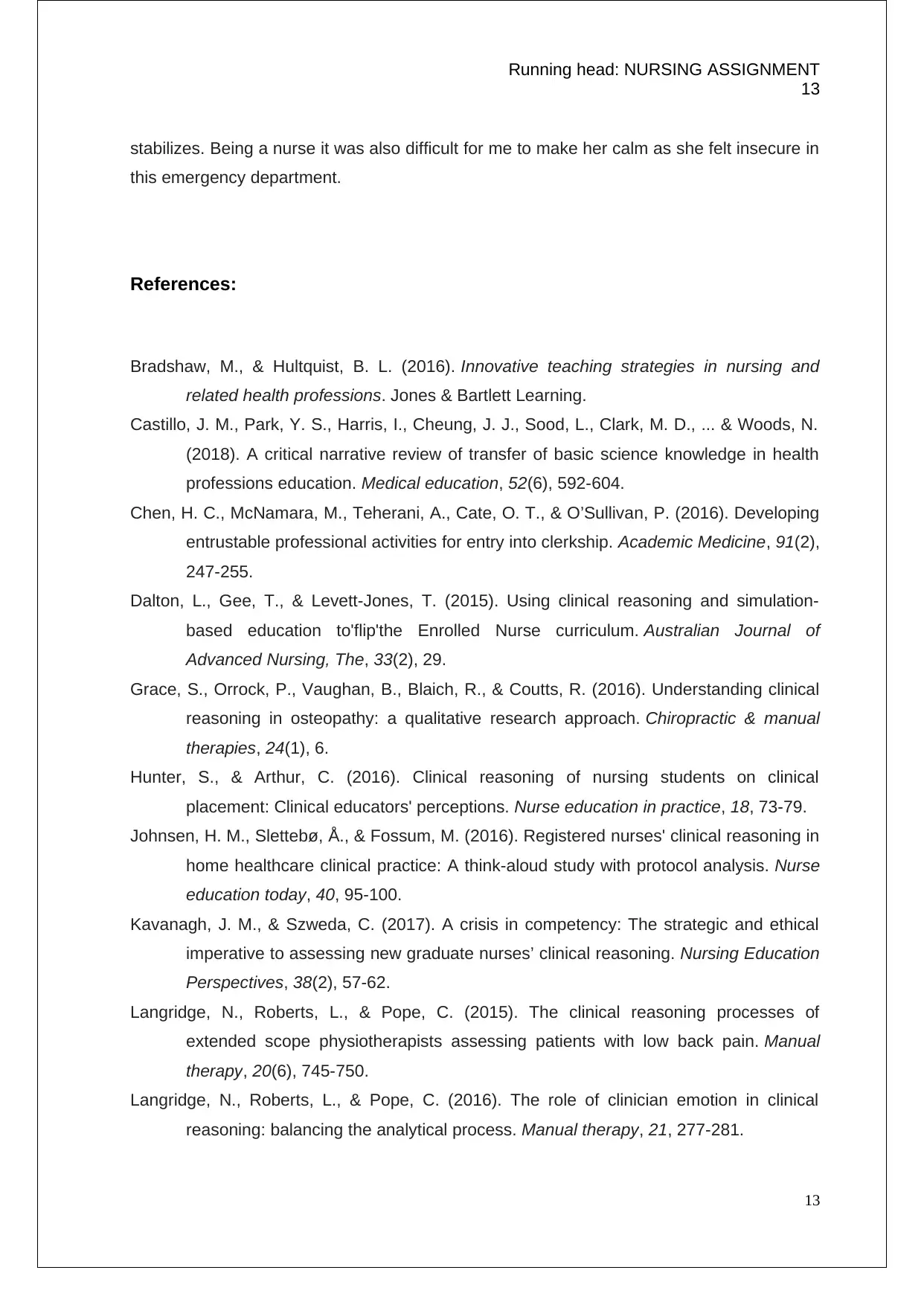
Running head: NURSING ASSIGNMENT
13
stabilizes. Being a nurse it was also difficult for me to make her calm as she felt insecure in
this emergency department.
References:
Bradshaw, M., & Hultquist, B. L. (2016). Innovative teaching strategies in nursing and
related health professions. Jones & Bartlett Learning.
Castillo, J. M., Park, Y. S., Harris, I., Cheung, J. J., Sood, L., Clark, M. D., ... & Woods, N.
(2018). A critical narrative review of transfer of basic science knowledge in health
professions education. Medical education, 52(6), 592-604.
Chen, H. C., McNamara, M., Teherani, A., Cate, O. T., & O’Sullivan, P. (2016). Developing
entrustable professional activities for entry into clerkship. Academic Medicine, 91(2),
247-255.
Dalton, L., Gee, T., & Levett-Jones, T. (2015). Using clinical reasoning and simulation-
based education to'flip'the Enrolled Nurse curriculum. Australian Journal of
Advanced Nursing, The, 33(2), 29.
Grace, S., Orrock, P., Vaughan, B., Blaich, R., & Coutts, R. (2016). Understanding clinical
reasoning in osteopathy: a qualitative research approach. Chiropractic & manual
therapies, 24(1), 6.
Hunter, S., & Arthur, C. (2016). Clinical reasoning of nursing students on clinical
placement: Clinical educators' perceptions. Nurse education in practice, 18, 73-79.
Johnsen, H. M., Slettebø, Å., & Fossum, M. (2016). Registered nurses' clinical reasoning in
home healthcare clinical practice: A think-aloud study with protocol analysis. Nurse
education today, 40, 95-100.
Kavanagh, J. M., & Szweda, C. (2017). A crisis in competency: The strategic and ethical
imperative to assessing new graduate nurses’ clinical reasoning. Nursing Education
Perspectives, 38(2), 57-62.
Langridge, N., Roberts, L., & Pope, C. (2015). The clinical reasoning processes of
extended scope physiotherapists assessing patients with low back pain. Manual
therapy, 20(6), 745-750.
Langridge, N., Roberts, L., & Pope, C. (2016). The role of clinician emotion in clinical
reasoning: balancing the analytical process. Manual therapy, 21, 277-281.
13
13
stabilizes. Being a nurse it was also difficult for me to make her calm as she felt insecure in
this emergency department.
References:
Bradshaw, M., & Hultquist, B. L. (2016). Innovative teaching strategies in nursing and
related health professions. Jones & Bartlett Learning.
Castillo, J. M., Park, Y. S., Harris, I., Cheung, J. J., Sood, L., Clark, M. D., ... & Woods, N.
(2018). A critical narrative review of transfer of basic science knowledge in health
professions education. Medical education, 52(6), 592-604.
Chen, H. C., McNamara, M., Teherani, A., Cate, O. T., & O’Sullivan, P. (2016). Developing
entrustable professional activities for entry into clerkship. Academic Medicine, 91(2),
247-255.
Dalton, L., Gee, T., & Levett-Jones, T. (2015). Using clinical reasoning and simulation-
based education to'flip'the Enrolled Nurse curriculum. Australian Journal of
Advanced Nursing, The, 33(2), 29.
Grace, S., Orrock, P., Vaughan, B., Blaich, R., & Coutts, R. (2016). Understanding clinical
reasoning in osteopathy: a qualitative research approach. Chiropractic & manual
therapies, 24(1), 6.
Hunter, S., & Arthur, C. (2016). Clinical reasoning of nursing students on clinical
placement: Clinical educators' perceptions. Nurse education in practice, 18, 73-79.
Johnsen, H. M., Slettebø, Å., & Fossum, M. (2016). Registered nurses' clinical reasoning in
home healthcare clinical practice: A think-aloud study with protocol analysis. Nurse
education today, 40, 95-100.
Kavanagh, J. M., & Szweda, C. (2017). A crisis in competency: The strategic and ethical
imperative to assessing new graduate nurses’ clinical reasoning. Nursing Education
Perspectives, 38(2), 57-62.
Langridge, N., Roberts, L., & Pope, C. (2015). The clinical reasoning processes of
extended scope physiotherapists assessing patients with low back pain. Manual
therapy, 20(6), 745-750.
Langridge, N., Roberts, L., & Pope, C. (2016). The role of clinician emotion in clinical
reasoning: balancing the analytical process. Manual therapy, 21, 277-281.
13
Paraphrase This Document
Need a fresh take? Get an instant paraphrase of this document with our AI Paraphraser
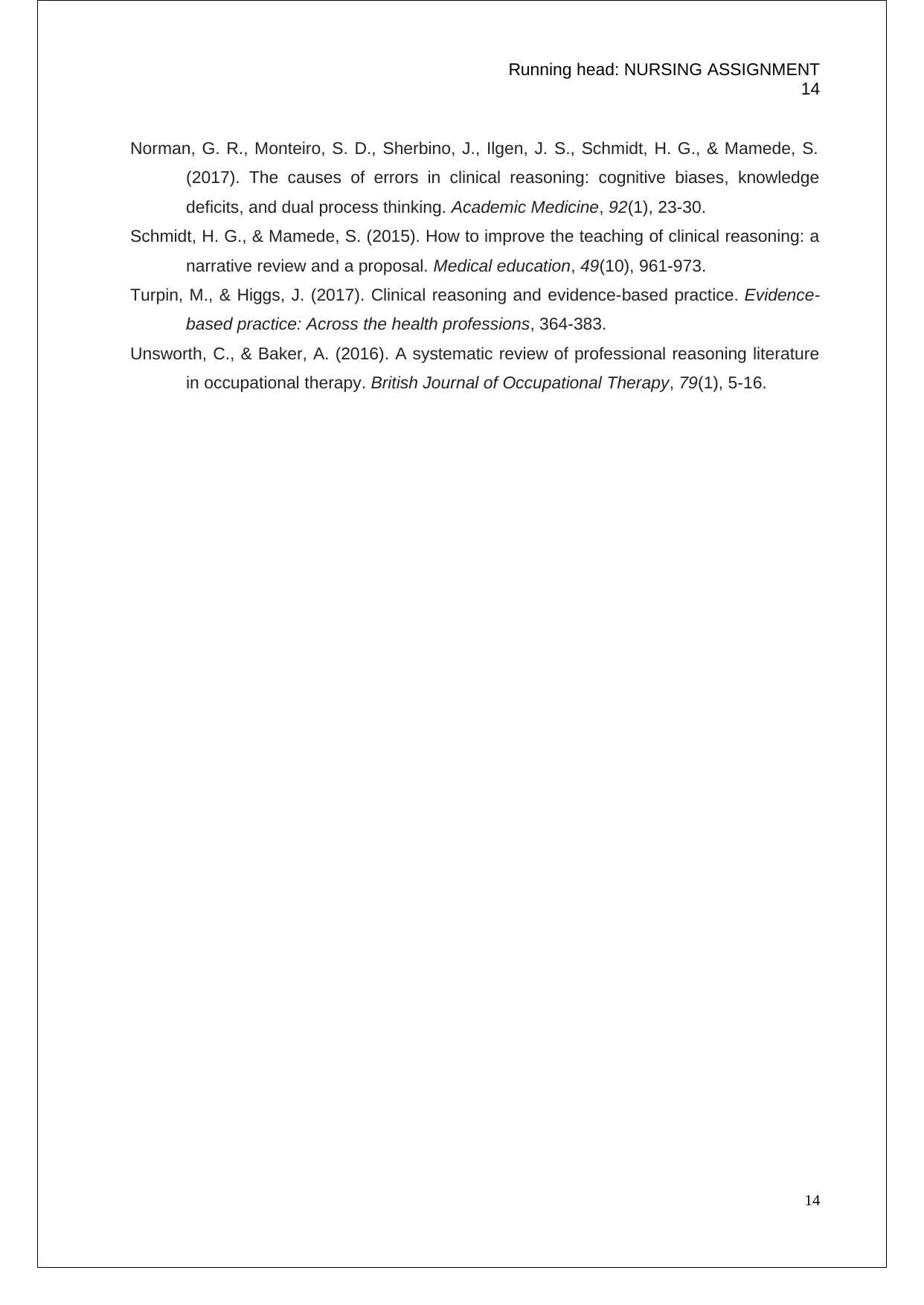
Running head: NURSING ASSIGNMENT
14
Norman, G. R., Monteiro, S. D., Sherbino, J., Ilgen, J. S., Schmidt, H. G., & Mamede, S.
(2017). The causes of errors in clinical reasoning: cognitive biases, knowledge
deficits, and dual process thinking. Academic Medicine, 92(1), 23-30.
Schmidt, H. G., & Mamede, S. (2015). How to improve the teaching of clinical reasoning: a
narrative review and a proposal. Medical education, 49(10), 961-973.
Turpin, M., & Higgs, J. (2017). Clinical reasoning and evidence-based practice. Evidence-
based practice: Across the health professions, 364-383.
Unsworth, C., & Baker, A. (2016). A systematic review of professional reasoning literature
in occupational therapy. British Journal of Occupational Therapy, 79(1), 5-16.
14
14
Norman, G. R., Monteiro, S. D., Sherbino, J., Ilgen, J. S., Schmidt, H. G., & Mamede, S.
(2017). The causes of errors in clinical reasoning: cognitive biases, knowledge
deficits, and dual process thinking. Academic Medicine, 92(1), 23-30.
Schmidt, H. G., & Mamede, S. (2015). How to improve the teaching of clinical reasoning: a
narrative review and a proposal. Medical education, 49(10), 961-973.
Turpin, M., & Higgs, J. (2017). Clinical reasoning and evidence-based practice. Evidence-
based practice: Across the health professions, 364-383.
Unsworth, C., & Baker, A. (2016). A systematic review of professional reasoning literature
in occupational therapy. British Journal of Occupational Therapy, 79(1), 5-16.
14
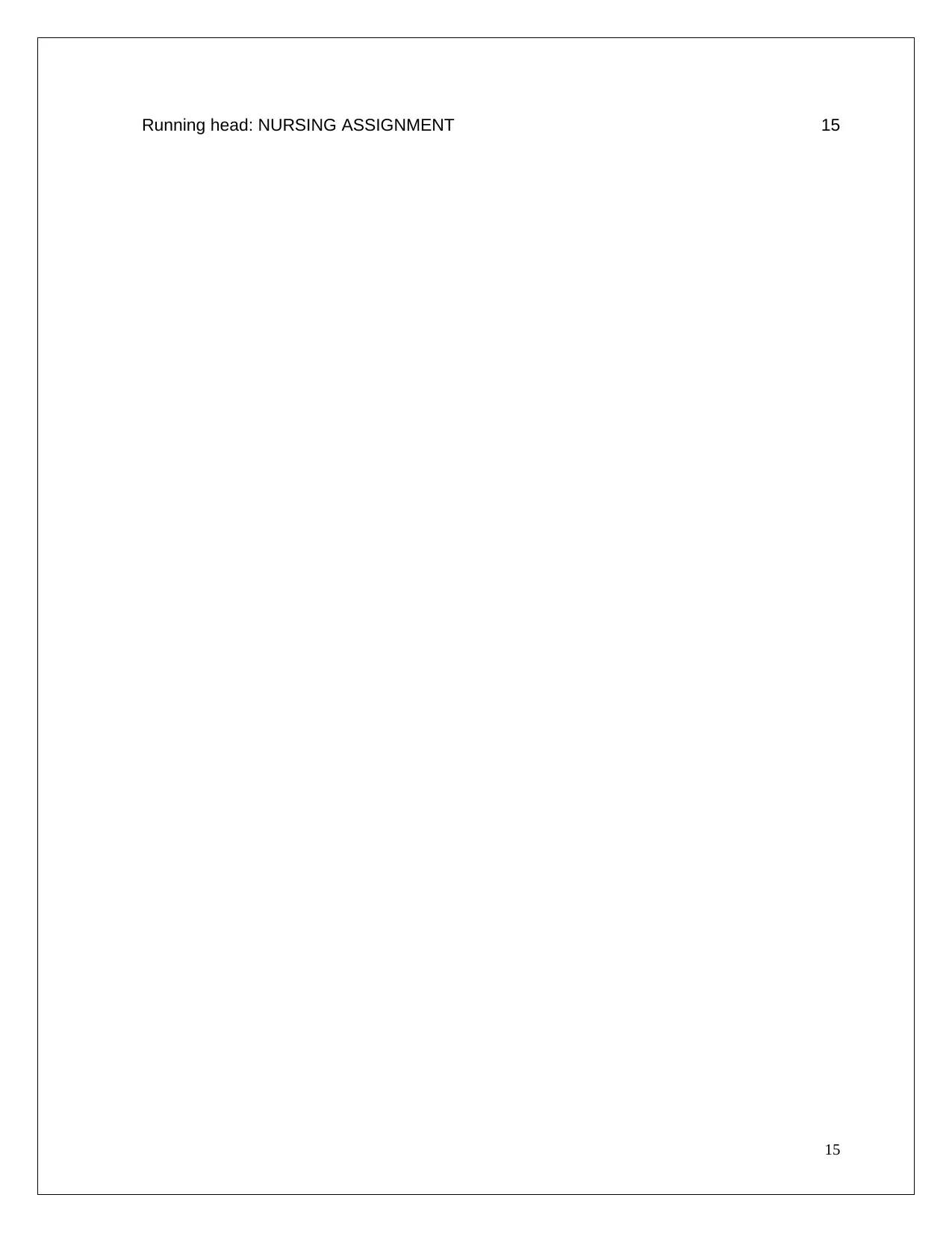
Running head: NURSING ASSIGNMENT 15
15
15
1 out of 15
Related Documents
Your All-in-One AI-Powered Toolkit for Academic Success.
+13062052269
info@desklib.com
Available 24*7 on WhatsApp / Email
![[object Object]](/_next/static/media/star-bottom.7253800d.svg)
Unlock your academic potential
© 2024 | Zucol Services PVT LTD | All rights reserved.





